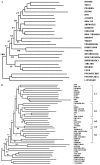Genetic relationship of populations in China
- PMID: 9751739
- PMCID: PMC21714
- DOI: 10.1073/pnas.95.20.11763
Genetic relationship of populations in China
Abstract
Despite the fact that the continuity of morphology of fossil specimens of modern humans found in China has repeatedly challenged the Out-of-Africa hypothesis, Chinese populations are underrepresented in genetic studies. Genetic profiles of 28 populations sampled in China supported the distinction between southern and northern populations, while the latter are biphyletic. Linguistic boundaries are often transgressed across language families studied, reflecting substantial gene flow between populations. Nevertheless, genetic evidence does not support an independent origin of Homo sapiens in China. The phylogeny also suggested that it is more likely that ancestors of the populations currently residing in East Asia entered from Southeast Asia.
Figures



Comment in
-
The Chinese human genome diversity project.Proc Natl Acad Sci U S A. 1998 Sep 29;95(20):11501-3. doi: 10.1073/pnas.95.20.11501. Proc Natl Acad Sci U S A. 1998. PMID: 9751692 Free PMC article. Review. No abstract available.
References
-
- Grimes B F. Ethnologue. 13th Ed. Dallas: Summer Institute of Linguistics; 1996.
-
- Zhao T M, Zhang G, Zhu Y, Zheng S, Liu D, Chen Q, Zhang X. Acta Anthropol Sin. 1986;6:1–8.
-
- Zhao T M, Lee T D. Hum Genet. 1989;83:101–110. - PubMed
-
- Weng Z, Yuan Y, Du R. Acta Anthropol Sin. 1989;8:261–268.
-
- Zhang Z B. Acta Anthropol Sin. 1988;7:314–323.
Publication types
MeSH terms
LinkOut - more resources
Full Text Sources

